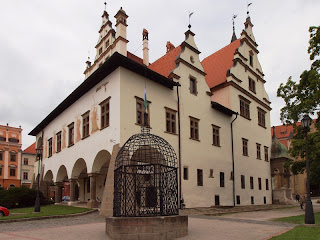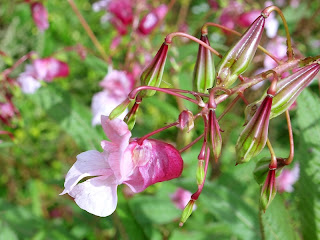Viewed from the Slovak (Southern) side, the High Tatras are
majestic as the highest peak – Lomnický Štít - below which we were camped, soars to a height of 2633 metres. It is possible to take a cable car to the
summit but as all the summits were enveloped in cloud for most of our visit we
didn’t do it. Thwarted again!!
We drove through several ski resorts and then descended to
the town of Levoča, staying at a site a few kilometres from the town and
were able to cycle in on a good, off-road cycle track. The medieval town walls are almost complete
but not very impressive …
And the old town inside them is slowly being restored. Outside the Town Hall, the “Cage of Shame” in
the photo used to be used as a punishment for naughty children!
Photography was not allowed inside the church which has a
huge altar-screen made by Master Paul – a local artist whose work can be seen
in several churches in this part of Slovakia – but this postcard shows his
depiction of the Last Supper which is part of the screen. We particularly liked the expressions on the
disciples’ faces!
We caught our first glimpse of Spiš Castle from the main road as
we travelled east.
Set on a rocky hill high above the town of Spišské
Podhradie it was first mentioned in a chronicle in 1209. Its military significance was as a defence
against invasion by the Turks and others but being privately owned it had
palaces added into it until the 16th century when new walled
settlement on a nearby hill largely took over this roll.
Destroyed by fire in 1780, it fell into ruins
until renovation was started in the 1970s.
Conservation and restoration continue to this day.
While there we were lucky enough to see a swallow-tail
butterfly …
… and Jane has been adding lots of photos to her large
collection of wild flowers such as this Himalayan Balsam.
After a couple of nights near the industrial town of Prešov,
we headed north to another delightful walled town – Bardejov. The town square was less pretentious than
some we had seen elsewhere but the Burghers' houses were lovely and, although
similar in shape, all were different from each other in detail.
The old Town Hall and Parish Church dominate the
square.
The Town Hall has some charming sculptures on the gable ends
of the roof …
… and the church has numerous ornate altars and an unusual
Rood Beam
A few kilometres east of Bardejov is Svidnik – a rather
uninspiring industrial town which does have a large open-air museum of rural
life in the late 19
th and early 20
th centuries. Several buildings from around the
area had been carefully dismantled and rebuilt there …
… including a fine example of a tiny wooden church which, as
we discovered, is still used for weddings.
Taking the road north, towards the Dukla Pass on the Polish
border, we entered an area that suffered very heavy fighting at the end of World
War ll. Russian tanks are still to be seen in the fields where they were
abandoned.
From there we travelled south west to a site at a very
popular local week-end/holiday spot.
No – it is not the Mediterranean but Tišava
on the banks of a long narrow lake. By
this time the weather had improved dramatically and the days were very
hot, sunny and rather sultry.
























































